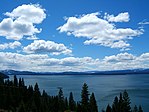Plumas County, California
| Plumas County, California | |||||
|---|---|---|---|---|---|
| County | |||||
| County of Plumas | |||||
Images, from top down, left to right: Lake Almanor, Beckwourth Pass, Trains at the Western Pacific Railroad Museum
|
|||||
|
|||||
 Location in the state of California |
|||||
 California's location in the United States |
|||||
| Country |
|
||||
| State |
|
||||
| Region | Sierra Nevada | ||||
| Incorporated | 1854 | ||||
| County seat | Quincy | ||||
| Area | |||||
| • Total | 2,613 sq mi (6,770 km2) | ||||
| • Land | 2,553 sq mi (6,610 km2) | ||||
| • Water | 60 sq mi (200 km2) | ||||
| Population (April 1, 2010) | |||||
| • Total | 20,007 | ||||
| • Estimate (2015) | 18,409 | ||||
| • Density | 7.7/sq mi (3.0/km2) | ||||
| Time zone | Pacific Standard Time (UTC-8) | ||||
| • Summer (DST) | Pacific Daylight Time (UTC-7) | ||||
| Website | www.countyofplumas.com | ||||
Plumas County is a county located in the Sierra Nevada of the U.S. state of California. As of the 2010 census, the population was 20,007. The county seat is Quincy, and the only incorporated city is Portola. The largest community in the county is East Quincy. The county gets its name from the Spanish words for the Feather River (Río de las Plumas), which flows through the county.
Prior to the California Gold Rush of 1849, the Mountain Maidu were the primary inhabitants of the area now known as Plumas County. The Maidu lived in small settlements along the edges of valleys, subsisting on roots, acorns, grasses, seeds, and occasionally fish and big game. There was no official tribal leadership, and most groups remained in and around their own valleys. Areas with high snowfall, including Mohawk and Sierra Valleys, provided hunting grounds in the warmer months.
Life quickly changed for the Mountain Maidu, however, when gold was discovered in the Sierra foothills in 1848. Miners were attracted to Plumas County in particular largely due to the wild tales of a man named Thomas Stoddard, whose claims of stumbling onto a lake lined with gold nuggets while lost in the wilderness attracted gold hungry prospectors to the area. Though hopeful miners scoured the glacial lakes of what is now Lakes Basin Recreation Area for months, they could not find the alleged lake of gold. However, some of them did have success in the rivers and creeks in the area, which led to the development of many of Plumas County’s first non-Indian settlements.
Towns quickly sprung up around successful mining areas, including Rich Bar, Indian Bar, and Rabbit Creek (now La Porte). The Feather River, named by Spanish explorer Captain Luis Arguello as "Río de las Plumas" in 1820, was the site of many of these settlements.
...
Wikipedia




